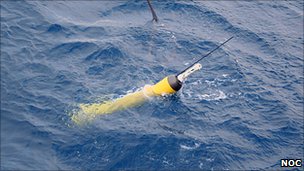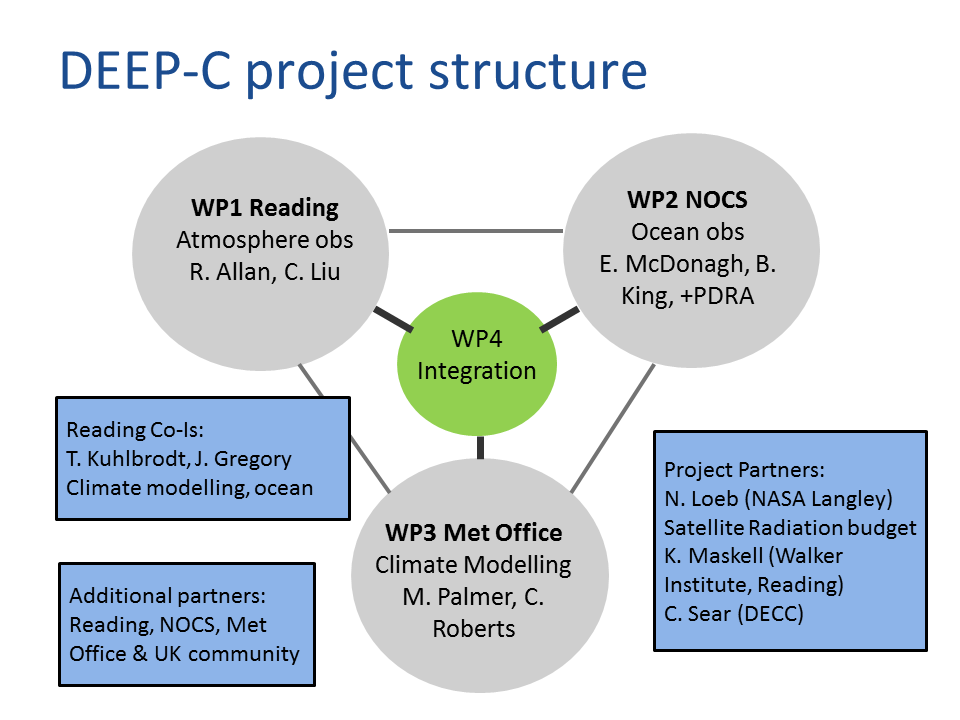DEEP-C project
The Diagnosing Earth's Energy Pathways in the Climate system (DEEP-C) consortium is a 4-year project that is tackling the questions:

(1) What mechanisms explain the reduced global surface warming rate since around 2000
(2) Where is the excess energy due to rising greenhouse gas concentrations currently accumulating in the climate system?

We are using satellite observations, measurements below the sea surface (including the deep ocean) and detailed simulations of the atmosphere and ocean, combining expertise from the University of Reading, the National Oceanography Centre (NOC) Southampton and the Met Office.
The project is funded by the Natural Environment Research Council (NERC) and runs from March 2013 - February 2017, involving partnerships with the NASA Langley Research Center and the UK Department for Energy and Climate Change (DECC) and collaboration with the National Centre for Earth Observation, the National Centre for Atmospheric Sciences-Climate and the Walker Institute for Climate Systems Research.
A more detailed outline of the rationale and work plan for DEEP-C is provided in the Project Proposal. Here are some further project links:
[PROJECT DESCRIPTION| LINKS | JOURNAL PAPERS | LATEST NEWS]

Meetings
Next meeting - 27th September 2013 Met Office (project partners)
Monday 22nd April 2013 - Kick-Off meeting with project partners, Department of Meteorology, University of Reading (ESSC seminar room, 10:30am-4:30pm) [Partners only].
[PROJECT DESCRIPTION| LINKS | LATEST NEWS]
Team members
[PROJECT DESCRIPTION| LINKS | LATEST NEWS]
Partner Publications
Allan, R.P. (2011), Combining satellite data and models to estimate cloud radiative effect at the surface and in the atmosphere, Meteorological Applications, 18, p.324-333, doi:10.1002/met.285.
Kuhlbrodt, T., R.S. Smith, Z. Wang and J.M. Gregory (2012): The influence of eddy parameterizations on the transport of the Antarctic Circumpolar Current in coupled climate models. Ocean Modelling, 52-53, 1-8, doi:10.1016/j.ocemod.2012.04.006
McCarthy, G.D., B. A. King, P. Cipollini, E. L. McDonagh, J. R. Blundell, and A. Biastoch, On the sub-decadal variability of South Atlantic Antarctic Intermediate Water (2012) Geophys. Res. Lett., 39, L10605.
Otto, A. et al. inc. Gregory, J.M. (2013) Energy budget constraints on climate response, Nature Geosciences, doi:10.1038/ngeo1836
Palmer, M.D. (2012), Climate and Earth's Energy Flows, Surv in Geophysics, doi: 10.1007/s10712-011-9165-8.
Palmer, M.D., D.J. McNeall and N.J. Dunstone (2011) Importance of the deep ocean for estimating decadal changes in Earth's radiation balance, Geophys. Res. Lett.. 38, L13707.
Loeb, N. G., J. M. Lyman, G. C. Johnson, R. P. Allan, D. R. Doelling, T. Wong, B. J. Soden and G. L. Stephens (2012), Observed changes in top-of-the-atmosphere radiation and upper-ocean heating consistent within uncertainty, Nature Geoscience, 5, 110-113, doi:10.1038/ngeo1375.
Lyman, J.M. et al. inc. M.D. Palmer (2010) Robust Warming of the Global Upper Ocean, Nature, 465, 334-337.
Smith, D. (2013) Has global warming stalled? Nature Climate Change 3, 618-619 doi: 10.1038/nclimate1938
[PROJECT DESCRIPTION| LINKS | LATEST NEWS]
DEEP-C NEWS
July 2013 - Press briefing at the Science Media Centre on the recent slowdown in global surface warming (see briefing note). Read More...
May 2013 - First DEEP-C publication (Prof. Gregory) Energy budget constraints on climate response, Nature Geosceinces (see also Science Media Centre | Guardian)
May 2013: Article on DEEP-C and how scientists measure Earth's temperature by Roz Pidcock from Carbon Brief
April 2013 - Meeting with DECC partners in London to discuss project
April 2013 - Science Media Centre briefing
April 2013 - DEEP-C Kick-Off Meeting at the University of Reading
March 2013 - Comments on misleading article in Daily Mail
[PROJECT DESCRIPTION| LINKS | LATEST NEWS]
Useful Links
Here is a growing list of links to journal papers, blogs and web links that are of relevance to the DEEP-C project which hopes to investigate in detail the flows of energy in the climate system and mechanisms influencing the recent hiatus in global mean surface warming.
[See Project Description above]
Web links
ARGO free-drifting ocean profiling floats
Clivar Carbon and Hydrographic Data Office (CCHDO)
Clouds and the Earth's Radiant Energy System (CERES)
European Centre for Medium-range Weather Forecasts (ECMWF) Interim Reanalysis (ERA Interim)
Discussion in Media/Blogs
ClimateLabBook and here | skepticalscience.com/ | sciencemediacentre.org | Bad Astronomy | carbonbrief.org | Myles Allen | RealClimate
JOURNAL PAPERS
Energy imbalance and ocean heating
Otto et al. (2013) Nature Geosci.: Latest estimates of radiative forcing and ocean heating consistent with climate model equilibrium climate sensitivity; recent decade suggest minority of models may underestimate rapidity of climate response up to point of CO2 doubling.
Loeb et al. (2012) Nature Geosci.: Observations show Earth contunued heating (at 0.5 Wm-2) since 2000
Levitus et al. (2012) GRL: ocean heat content and thermosteric sea level change since 1955
Hansen et al. (2011) ACP: Observed heating of 0.6 Wm-2 2005-2010; discusses contribution of changes in rate of radiative forcing increase and errors in ocean heat uptake.
Church et al. (2011) GRL: increasing sea level and ocean heating consistent; aerosol forcing (as a residual term) may have increased in the late 1990s
Allan, R.P. (2011) Met. Apps.: Observed variations in 60S-60N mean net radiative fluxes since 1985; influence of volcanoes + ENSO but no evidence of decerease over the period
Lyman et al. (2010) Nature: observed ocean heating rate down to 700m 1993-2008
Modelling
Meehl et al. (2013) J Climate: Role of Interdecadal Pacific Oscillation (IPO) in determining accelerated warming and hiatus decades (extension of Meehl et al. 2011). No surface warming for 15 years is common in grerenhouse gas forced simulations.
Watanabe et al. (2013) GRL: increased observed ocean heat uptake explains slower surface temperature rise compared to CMIP5 simulations
Meehl et al. (2011) Nature Climate Change: Hiatus decades identified in simulations with increasing greenhouse gas forcing and are characterized by increased ocean heating below 300m.
Katsman and van Oldenborgh (2011) GRL: simulations suggest a mix of natural variability and increased ocean heating at depth contribute to hiatus periods in the surface temperature record
Palmer et al. (2011) GRL: full depth of ocean required to reconcile top of atmosphere radiative imbalance with heating of the climate system
Easterling and Wehner (2009) GRL: models simulate hiatus periods under increasing greenhouse gas forcing.
Unforced Variability
L'Heureux et al. (2013) Nature Climate Change - trends towards a stronger, La Nina-like Walker circulation?
Balmaseda et al. (2013) GRL: increased ocean heating below 700m due to surface wind forcing may have contributed to surface warming hiatus since 2004.
Guemas et al. (2013) Nature Climate Change: initialisation of models helps to explain hiatus due to changes in upper ocean heating linked to natural variability (see also comment by DEEP-C Met Office partner, Doug Smith)
Sohn et al. (2013) Climate Dynamics: recent observed variations in the Walker circulation inconsistent with climate models
Chikamoto et al. (2012) GRL: rather than cycles, step-wise shifts are an important manifestation of natural unforced climate variability
Foster and Rahmstorf (2011) ERL: warming trend evident in recent period when ENSO is accounted for
Merrifield (2011) J Climate: an observed shift in Pacific ocean circulation during the 1990s
Knight et al. (2009) BAMS state of the climate: Do global temperature trends over the last Decade falsify climate prediction?
Radiative Forcing
Fyfe et al. (2013) GRL: simulations show observed increases in stratospheric aerosol concentration since the late 1990s has decrease the rate of global warming.
Murphy (2013) Nature Geosciences: no evidence for increased direct aerosol cooling effect 2000-2012
Huber and Knutti (2012) Nature Geoscience
Solomon et al. (2011) Science: small but significant cooling effect from volcanic eruptions since 2000
Kaufmann et al. (2011) PNAS: the solar cycle, changes in sulfate aerosol and natural variability mask greenhouse gas warming in 1998-2008 period
Solomon et al. (2010) Science: changes in stratospheric water vapour may influence decadal temperature trends
Murphy et al. (2009) JGR: infer aerosol radiative forcings as a residual between measured terms (greenhouse gas and natural forcings, ocean heat content, outgoing radiation to space)
Deep Ocean Heating
Masuda et al. (2010) : computer simulations reveal fast teleconnection between changes in air-sea heat flux off the Adélie Coast of Antarctica and the bottom-water warming in the North Pacific.
Purkey & Johnson (2010) Observed ocean heating from 1990s-2000s below 4000m and 1000-4000m in southern ocean equivalent to nearly 0.1 Wm-2 globally
Kouketsu et al. (2010): Observationally-derived estimates of heating below 3000m from 1990s-2000s of about 0.05 Wm-2
Other relevant papers
Cohen et al. (2012) GRL: hiatus influenced strongly by northern hemisphere land (away from the tropics) in winter.
Kennedy et al. (2012) Remote Sensing of Environment: uncertainty in sea surface temperature record
Nuccitelli et al. (2012) Physical Letters A: errors in methodology for estimating ocean heating rate.
Simmons et al. (2009) JGR: declining trends in relative humidity over land in recent decade
[PROJECT DESCRIPTION| LINKS | LATEST NEWS]
Richard P. Allan Location: Department of Meteorology (2U15)